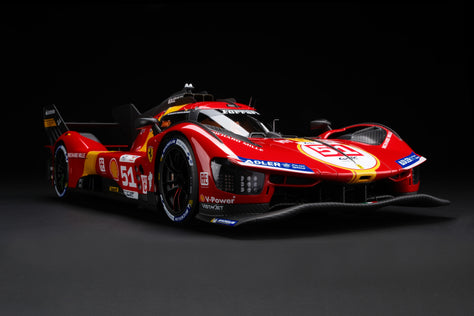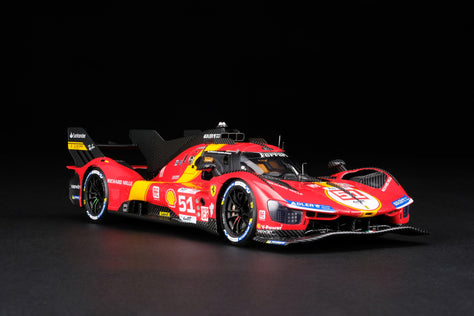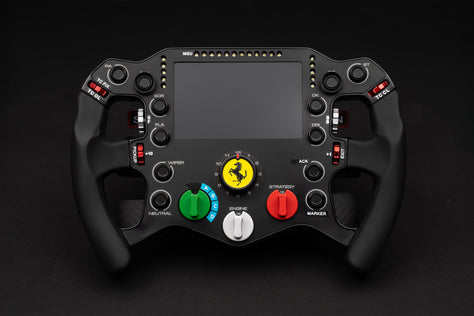Technical Details
- Description
- Scale guide
- Limited Edition of 499 pieces per livery
- The #50 Hypercar edition is based on the car raced to victory by Miguel Molina, Antonio Fuoco and Nicklas Nielsen in the 24 Hours of Le Mans at Circuit de la Sarthe on the 15th and 16th of June 2024
- The #51 Hypercar edition is based on the car raced to third by Alessandro Pier Guidi, James Calado and Antonio Giovinazzi
- Each model hand-built and assembled by a small team of craftsmen
- Complete with opening doors and engine cover
- 1:8 scale model, measuring over 63 cms/ 25 inches long
- Over 4000 hours to develop the model
- Over 400 hours to build each model
- Made using the finest quality materials
- Thousands of precisely engineered parts: castings, photo-etchings and CNC machined metal components
- Built using original CAD designs based on scans of a real car
- Original paint codes and material specifications supplied by Ferrari
- Officially licensed 24 Hours of Le Mans product
The car that returned Scuderia Ferrari to the pinnacle of sportscar racing, the 499P was Ferrari’s first foray into the newly created Hypercar class in the FIA World Endurance Championship, where it has won the fabled 24 Hours of Le Mans two years running. Introduced for the 2023 season, the 499P marked Ferrari’s reappearance in the elite class of endurance racing for the first time in 50 years.
Winning DNA
Whilst the car is undeniably designed to lead Ferrari into the future, the 499P moniker evokes the history of the Maranello manufacturer, a naming system dating back to its previous Le Mans entries; the 499 refers to the unitary displacement of its engine, while the P stands for Prototype. The Hypercar also sports a livery in the same colours as the 312P from 1973 as a nod to Ferrari's last involvement in endurance racing half a century ago, recalling a long association with a competition core to the DNA of the Ferrari brand. The cars’ race numbers were decided for similar reasons – the number 50 highlighting the length of time that Ferrari had been absent from the top class at Le Mans, and the number 51 has adorned a winning Ferrari GT car on four occasions.
New Hybrid Power and Innovative Technology
In defining the 499P, Ferrari drew upon their vast resources of technical, professional and human excellence that epitomise the Maranello marque, entrusting the management to Attività Sportive GT, under the direction of Antonello Coletta and the technical supervision of Ferdinando Cannizzo, head of the department in charge of engineering and development of Sports and GT racing cars. The design, whilst restricted by aerodynamic and packaging requirements, remains unmistakably a Ferrari, unsurprisingly for a car purely designed and manufactured in Maranello, refined with the support of the Ferrari Styling Centre under the direction of Flavio Manzoni. The car’s technical and aerodynamic features have been enhanced by means of simple, sinuous shapes: an explicit expression of Ferrari’s DNA. The balance between tense lines and flowing surfaces, expressed in a futuristic, pure and iconic language, defines a clear yet essential architecture. Sculpted bodywork encourages aerodynamic flows through the side pods, cooling the radiators concealed beneath. The wheel arches are characterised by large louvres and, together with the headlight clusters, imbue the nose with a sense of character and expressiveness, with subtle references to the styling traits first introduced on the Ferrari Daytona SP3. The rear is the ultimate expression of how to blend technology, aerodynamics and design; a subtle carbon-fibre skin covers the various functions, leaving the wheels and suspension completely visible. The tail is characterised by a double horizontal wing; the main wing and upper flaps have been meticulously designed to guarantee the necessary downforce and achieve maximum performance. The lower wing also features a ‘light bar’ that enriches the rear design with a decisive yet minimalist touch.
Built on an all-new carbon-fibre monocoque chassis, the 499P features solutions that represent the cutting edge of motor sport technology. Double wishbone, push-rod-type suspension provides an outstanding damping stiffness, the benefits of which are felt on the straights as well as when cornering. The electronics systems are developed from and further innovate upon the experience honed in the world of GT racing. The Hypercar features a hybrid powertrain, combining a mid-rear power unit with an electric motor powering the front axle, and is coupled to a seven-speed sequential gearbox. The 2.9-litre, twin-turbo V6 used is the same engine used in the 296 GT3 and its road-going cousins, with a maximum power output of 500kW (680cv). Added here is an Energy Recovery System (ERS) that’s connected to the front axle, and fed by a brake-by-wire system. The ERS is good for 200 kW, and the battery that powers it uses know-how accrued from Ferrari’s vast F1 experience. Among the specific characteristics of the 499P's V6 is the fact that the engine is load-bearing and therefore performs a valuable structural function, compared to the versions fitted to competition GT cars, where the engine is mounted onto the car’s rear sub-chassis.
Competition History
The Ferrari 499P is managed on track by Maranello technicians and engineers with the collaboration of Racing Partner AF Corse, extending the long-successful partnership that began back in 2006. For the 2023 FIA World Endurance Championship (WEC) season, Ferrari GT racers Antonio Fuoco, Miguel Molina and Nicklas Nielsen took control of the #51 car, whilst two-time LMGTE Pro World Champions Alessandro Pier Guidi and James Calado were joined by Ferrari’s Formula 1 Reserve Driver Antonio Giovinazzi behind the wheel of the #51 sister car.
The eagerly awaited debut of the 499P would come at the 1000 Miles of Sebring, with the #50 car establishing an early benchmark by securing pole position. However, despite leading off the line, the Ferrari would be overtaken by the two Toyota Gazoo Racing entries, eventually finishing third, claiming a podium on Ferrari’s return to Prototype endurance racing. Ultimately the 499P was often outpaced by the Toyotas, who secured the title for a fifth year in succession, but Ferrari remained ahead of the other manufacturers. After only once failing to secure a podium all season, Ferrari AF Corse were the only real challengers to the Japanese team, and both cars took the championship battle to the season finale in Bahrain. The highlight of the season though came at the famed 24 Hours of Le Mans: the #50 again qualifying on Hyperpole, but it was the #51 car with Pier Guidi, Calado and Giovinazzi that would secure a victorious return to Circuit de la Sarthe after an intense and dramatic contest.
For the 2024 season, Ferrari AF Corse introduced a third 499P: the #83, raced by official Ferrari drivers Yifei Ye and Robert Shwartzman, and FIA WEC LMP2 champion and Formula 1 race winner Robert Kubica. It was at Le Mans again that the 499P would shine: this time, it was Fuoco, Molina and Nielsen in the #50 who registered outright victory, claiming Ferrari’s eleventh success at the race. In an ever-increasingly competitive championship now featuring nine separate manufacturers, the team remain right in the fight for the title amongst entries from Porsche and Toyota.
24 Hours of Le Mans, 15th and 16th of June 2024
These models of the Ferrari 499P are perfect 1:8 scale recreations of the #50 and #51 Hypercars raced by Miguel Molina, Antonio Fuoco and Nicklas Nielsen, Alessandro Pier Guidi, James Calado and Antonio Giovinazzi in the 24 Hours of Le Mans at Circuit de la Sarthe on the 10th and 11th of June 2023. The #50 car claimed Ferrari’s second successive win, following the success of the sister #51 car the previous year, in only the marque’s second appearance in the elite class at Le Mans in 51 years.
The grid consisted of 62 cars, with a record-breaking 23 Hypercars from nine manufacturers competing alongside the LMP2 cars and the new LMGT3 class. The field featured a diverse range of 186 drivers, including previous Le Mans winners, former Formula 1 drivers, current NTT INDYCAR SERIES racers, and GT racing champions. Alongside the #51 and #50 cars, Ferrari AF Corse also entered the yellow-liveried #83, driven by Robert Kubica, Robert Shwartzman and Yifei Ye. Ferrari arrived at Le Mans amid intense competition, trailing Toyota and Porsche in the Hypercar World Endurance Manufacturers' Championship despite having the comparable race pace. In qualifying, Porsche claimed pole position with the #6 car, followed by Cadillac’s #3 car in second. Ferrari’s #51 and #50 entries were to start third and fourth, Fuoco in the #50 left particularly frustrated after a red flag ended what looked like a very promising lap, while the #83 could only manage twelfth.
From the race start, the Ferraris were on the pace, Nielsen and Giovinazzi in the #50 and #51 cars seizing the lead after just 13 minutes. Kubica in the #83 had started the race in an equally determined manner, rapidly climbing to fifth place. As the rain began to fall around the two-hour mark, the teams were forced into early strategy decisions. Several hypercars, including the red-liveried Ferraris, switched to wet-weather tyres early. Kubica in the #83, however, stayed on soft slick tyres, mastering his car in the damp conditions. As the track dried, Shwartzman took over the drive and took off, his lead steadily increasing over the chasing #8 Toyota and the #5 Porsche. The rain returned around the sixth hour, triggering another series of pit stops. This time, the #83 stopped for wet tyres and, once again, had judged the conditions perfectly, gaining up to 30 seconds a lap over some of its rivals. However, the #83, then with Kubica at the wheel, was then involved in a collision with the #15 BMW of Dries Vanthoor, sending the Belgian racer into the wall as he tried to unlap himself. The incident triggered a lengthy safety car period of over ninety minutes, and the stewards shortly found Kubica at fault, handing down a 30-second penalty stop and go penalty, dropping the #83 back into the pack. At the nine-hour mark, the #50, #83 and #51 Ferrari trio were fifth, sixth and seventh, trailing the #8 Toyota, #6 Porsche, #7 Toyota and #2 Cadillac. Deep into the night, Race Control triggered a Safety Car period for almost four-and-a-half hours after, due to a combination of continuous heavy rain and low visibility in the dark. The race resumed just after the sixteen-hour mark, with the #50 in third, and the #83 fifth, having gained positions in the pit stop periods. Giovinazzi in the #51 maintained seventh place, though soon received a drive-through penalty for incorrect speeds during a full course yellow. The battle for position continued until another hour of safety car, this time triggered by a big crash in the GT class, bunching up the Hypercars again.
Seven hours from the end, 11 cars were still on the lead lap and could still vie for victory. The rain ceased, and the battle was intense as cars jostled for position: Cadillac lost two cars, an oil leak stopping the #3 and a spectacular accident ending the #311 Cadillac’s hopes; Porsche lost the #4 car after a crash at Indianapolis, whilst #5 and #6 were lagging. Ferrari weren’t immune, the #83 pulling into the pits with smoke billowing from the brakes before being diagnosed with a terminal hybrid system issue. Ultimately, it looked like a repeat of last year’s finale, as the remaining #50 and #51 Ferraris took on the #7 and #8 Toyotas. However, a mistake by Pier Guidi in the #51 span the #8 Toyota around at Mulsanne corner, and the Italian was duly punished with a five second penalty. It looked like further advantage was handed to Toyota when Nielsen was forced to bring the #50 into the pits when the car’s right-hand door came loose. With fifty minutes to go, this off-sequence stop should have left the 499P requiring one final visit to the pits; but Ferrari were confident that the car could stretch its fuel load, a strategy that would come under deep scrutiny when the #7 Toyota came in for its final stop less than ten minutes later, knowing it would reach the end. Twenty minutes later, there was a growing realisation amongst the teams and fans that Ferrari had pulled off a masterstroke as Nielsen expertly managed his machine to the chequered flag, securing a second successive win for Ferrari by a margin of 14.221 seconds. Despite the late penalty, the #51 crossed the line to claim the final podium position, denying the pole-sitting #6 Porsche by a mere 1.167 seconds over the line. This success marked the Prancing Horse’s 11th overall victory in the classic French endurance race, adding to 29 class wins, for a total of 40 victories. By triumphing at the 92nd 24 Hours of Le Mans and the Monaco Formula 1 GP, Ferrari was also the first manufacturer to climb to the top step of the podium in two of the world’s most prestigious races in the same year since 1934.
The Ferrari 499P is limited to 499 pieces per livery at 1:8 scale.
--------------------------------------------------------------
This model is a part of the 24 Hours of Le Mans Collection.
Pre-order
Bespoke
In order for us to create your bespoke model, you will need to choose 4 extra options. Paint colour, interior colour, wheel style and caliper colour.
Please complete the form and a member of our Sales Team will contact you.
Contact Us
Please contact us for more information about ordering this model.






